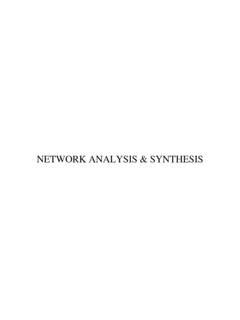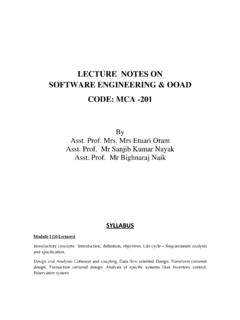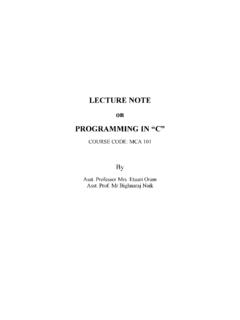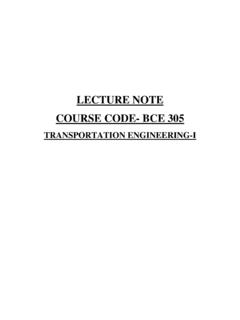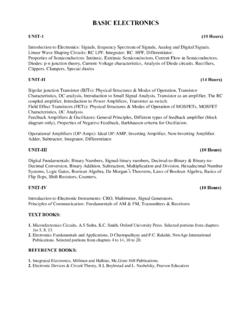Transcription of INFORMATION SECURITY LECTURE NOTES
1 INFORMATION SECURITY LECTURE NOTES (Subject Code: BIT 301) for Bachelor of Technology in INFORMATION Technology Department of Computer Science and Engineering & INFORMATION Technology Veer Surendra Sai University of Technology (Formerly UCE, Burla) Burla, Sambalpur, Odisha LECTURE Note Prepared by: Sumitra Kisan D. Chandrasekhar Rao SYLLABUS BIT-301 INFORMATION SECURITY (3-1-0) Credit-04 Module I (10 LECTURES) The SECURITY Problem in Computing: The meaning of computer SECURITY , Computer Criminals, Methods of Defense, Elementary Cryptography: Substitution Ciphers, Transpositions, Making Good Encryption algorithms, The Data Encryption Standard, The AES Encryption Algorithms, Public Key Encryptions, Uses of Encryption.
2 Module II (10 LECTURES) Program SECURITY : Secure Programs, Nonmalicious Program Errors, viruses and other malicious code, Targeted Malicious code, controls Against Program Threats, Protection in General- Purpose operating system protected objects and methods of protection memory and addmens protection, File protection Mechanisms, User Authentication Designing Trusted : SECURITY polices, models of SECURITY , trusted design, Assurance in trusted Implementation examples. Module III (10 LECTURES) Data base SECURITY : SECURITY requirements, Reliability and integrity, Sensitive data, Inference, multilevel database, proposals for multilevel SECURITY .
3 SECURITY in Network: Threats in Network, Network SECURITY Controls, Firewalls, Intrusion Detection Systems,Secure E-Mail. Module IV (10 LECTURES) Administering SECURITY : SECURITY Planning, Risk Analysis, Organizational SECURITY policies, Physical SECURITY . Legal Privacy and Ethical Issues in Computer SECURITY : Protecting Programs and data, INFORMATION and the law, Rights of Employees and Employers, Software failures, Computer Crime, Praia, Ethical issues in Computer SECURITY , case studies of Ethics. MODULE 1 The SECURITY problem in computing The meaning of computer SECURITY The meaning of the term computer SECURITY has evolved in recent years.
4 Before the problem of data SECURITY became widely publicized in the media, most people s idea of computer SECURITY focused on the physical machine. Traditionally, computer facilities have been physically protected for three reasons: To prevent theft of or damage to the hardware To prevent theft of or damage to the INFORMATION To prevent disruption of service Computer SECURITY is SECURITY applied to computing devices such as computers and smartphones, as well as computer networkssuch as private and public networks, including the whole Internet. The field covers all the processes and mechanisms by which digital equipment, INFORMATION and services are protected from unintended or unauthorized access, change or destruction, and are of growing importance in line with the increasing reliance on computer systems of most societies worldwide.
5 It includes physical SECURITY to prevent theft of equipment, and INFORMATION SECURITY to protect the data on that equipment. It is sometimes referred to as "cyber SECURITY " or "IT SECURITY ", though these terms generally do not refer to physical SECURITY (locks and such). Some important terms used in computer SECURITY are: Vulnerability Vulnerability is a weakness which allows an attacker to reduce a system's INFORMATION assurance. Vulnerability is the intersection of three elements: a system susceptibility or flaw, attacker access to the flaw, and attacker capability to exploit the flaw. To exploit vulnerability, an attacker must have at least one applicable tool or technique that can connect to a system weakness.
6 In this frame, vulnerability is also known as the attack surface. Vulnerability management is the cyclical practice of identifying, classifying, remediating, and mitigating practice generally refers to software vulnerabilities in computing systems. Backdoors A backdoor in a computer system, is a method of bypassing normal authentication, securing remote access to a computer, obtaining access to plaintext, and so on, while attempting to remain undetected. The backdoor may take the form of an installed program ( , Back Orifice), or could be a modification to an existing program or hardware device. It may also fake INFORMATION about disk and memory usage. Denial-of-service attack Unlike other exploits, denials of service attacks are not used to gain unauthorized access or control of a system.
7 They are instead designed to render it unusable. Attackers can deny service to individual victims, such as by deliberately entering a wrong password enough consecutive times to cause the victim account to be locked, or they may overload the capabilities of a machine or network and block all users at once. These types of attack are, in practice, very hard to prevent, because the behaviour of whole networks needs to be analyzed, not only the behaviour of small pieces of code. Distributed denial of service (DDoS) attacks are common, where a large number of compromised hosts (commonly referred to as "zombie computers", used as part of a botnet with, for example; a worm, trojan horse, or backdoor exploit to control them) are used to flood a target system with network requests, thus attempting to render it unusable through resource exhaustion.
8 Direct-access attacks An unauthorized user gaining physical access to a computer (or part thereof) can perform many functions, install different types of devices to compromise SECURITY , including operating system modifications, software worms, key loggers, and covert listening devices. The attacker can also easily download large quantities of data onto backup media, for instance CD-R/DVD-R, tape; or portable devices such as key drives, digital cameras or digital audio players. Another common technique is to boot an operating system contained on a CD-ROM or other bootable media and read the data from the hard drive(s) this way. The only way to defeat this is to encrypt the storage media and store the key separate from the system.
9 Direct-access attacks are the only type of threat to Standalone computers (never connect to internet), in most cases. Eavesdropping Eavesdropping is the act of surreptitiously listening to a private conversation, typically between hosts on a network. For instance, programs such as Carnivore and NarusInsight have been used by the FBI and NSA to eavesdrop on the systems of internet service providers. Spoofing Spoofing of user identity describes a situation in which one person or program successfully masquerades as another by falsifying data and thereby gaining an illegitimate advantage. Tampering Tampering describes an intentional modification of products in a way that would make them harmful to the consumer.
10 Repudiation Repudiation describes a situation where the authenticity of a signature is being challenged. INFORMATION disclosure INFORMATION Disclosure (Privacy breach or Data leak) describes a situation where INFORMATION , thought as secure, is released in an untrusted environment. Elevation of privilege Elevation of Privilege describes a situation where a person or a program want to gain elevated privileges or access to resources that are normally restricted to him/it. Exploits An exploit is a piece of software, a chunk of data, or sequence of commands that takes advantage of a software "bug" or "glitch" in order to cause unintended or unanticipated behaviour to occur on computer software, hardware, or something electronic (usually computerized).
